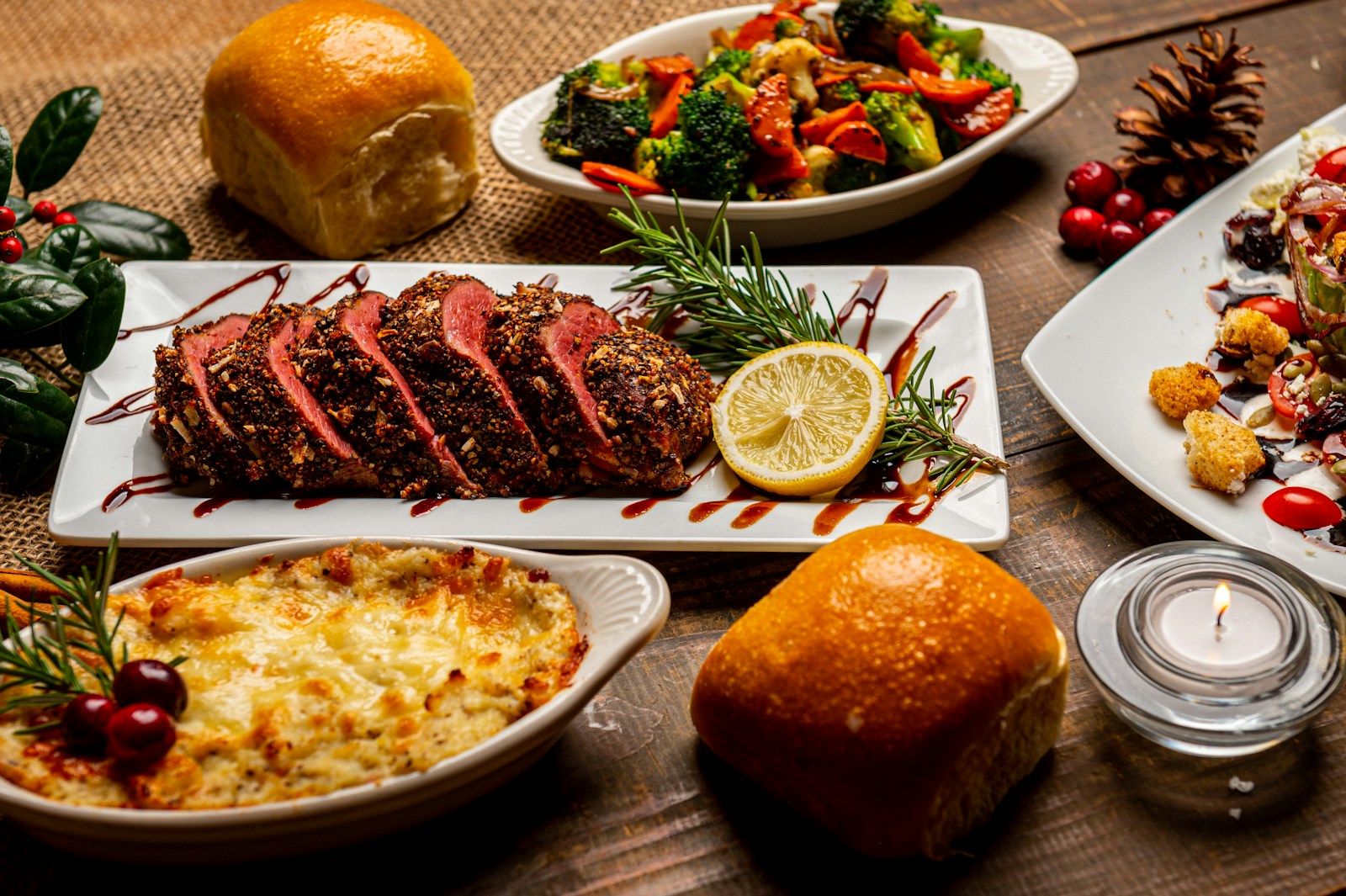When planning a festive Christmas feast with sustainability in mind, start by selecting locally sourced ingredients.
Choosing foods that are grown or produced near your home reduces the carbon footprint associated with transportation. Visit local farmers markets or research nearby farms to find fresh, in-season fruits, vegetables, and other ingredients for your holiday menu.
Minimizing food waste is another crucial aspect of hosting a green Christmas feast. To avoid excess leftovers, plan your menu carefully based on the number of guests attending. Consider serving smaller portions and encouraging guests to take only what they will eat. Additionally, think creatively about how to use leftover ingredients in subsequent meals to ensure that nothing goes to waste. By being mindful of your ingredient quantities and usage, you can help reduce the environmental impact of your holiday celebration.
Selecting Locally Sourced Ingredients
When planning your green Christmas feast, selecting locally sourced ingredients is a crucial step in reducing your carbon footprint and supporting your local community. By choosing ingredients that are grown or produced nearby, you are helping to minimize the environmental impact of transportation and supporting local farmers and producers.
Locally sourced ingredients also tend to be fresher and of higher quality, enhancing the flavors of your dishes and providing a more authentic dining experience for your guests. Look for local farmers’ markets, co-ops, and farm stands where you can find a variety of seasonal ingredients to incorporate into your holiday menu. By prioritizing locally sourced ingredients, you can create a more sustainable and delicious feast for a festive and eco-friendly celebration.
Minimizing Food Waste
When planning your green Christmas feast, reducing food waste should be a top priority. One effective way to minimize waste is by carefully calculating the portion sizes to ensure that there is just enough food for all your guests. Be mindful of the number of people attending and adjust your recipes accordingly to avoid cooking more than necessary. It’s better to have a bit of leftovers than to throw away excess food that goes uneaten.
Another helpful tip for minimizing food waste is to repurpose leftovers creatively. Instead of throwing out unused ingredients or cooked dishes, consider incorporating them into new meals. Leftover vegetables can be added to soups or salads, while excess meat or poultry can be turned into sandwiches or stir-fries. By thinking ahead and planning to use up leftovers, you can significantly reduce the amount of food that ends up in the trash.
Choosing Sustainable Protein Options
When considering sustainable protein options for your Christmas feast, it’s vital to prioritize ethically sourced ingredients that have minimal environmental impact. Opting for locally caught or raised seafood, such as responsibly sourced fish or shellfish, can support local producers and reduce the carbon footprint of your meal. Additionally, selecting plant-based proteins like beans, lentils, or tofu can offer a sustainable and nutritious alternative that is gentle on the planet.
Another eco-conscious choice for sustainable protein options is to incorporate pasture-raised, organic meats into your holiday menu. These options typically have lower environmental impacts than conventionally raised meats, as they often involve practices that prioritize animal welfare and land stewardship. By making thoughtful choices about the protein sources on your Christmas table, you can enjoy a delicious feast while also supporting sustainable food practices.
Opting for Organic Produce
When planning your green Christmas feast, consider incorporating organic produce into your menu. Opting for organic fruits and vegetables can not only benefit your health but also support sustainable farming practices. By choosing organic produce, you are reducing exposure to pesticides and harmful chemicals, while also promoting a healthier environment for both the soil and surrounding wildlife.
Additionally, organic produce is often fresher and more flavorful, adding a vibrant and wholesome element to your holiday dishes. Look for local farmers markets or organic grocery stores to source your ingredients, ensuring that your Christmas feast is not only delicious but also environmentally friendly. Prioritizing organic produce is a simple yet impactful way to make your holiday meal both conscious and enjoyable for all your guests.

Using Reusable Dinnerware and Utensils
When hosting a green Christmas feast, opting for reusable dinnerware and utensils is a simple yet effective way to reduce waste. By using dishes, glasses, and cutlery that can be washed and reused, you can minimize the need for single-use plastics and paper products that often end up in landfills. Not only does this help the environment, but it also adds a touch of elegance to your holiday table setting.
Investing in high-quality reusable dinnerware and utensils may require an initial cost, but the long-term benefits for the planet are invaluable. Look for durable materials such as ceramic, glass, stainless steel, or bamboo that can withstand repeated use and dishwasher cycles. Additionally, consider purchasing sets that match your existing tableware to maintain a cohesive look while being sustainable.
Decorating with Natural Materials
For a sustainable and eco-friendly approach to decorating your Christmas feast, consider incorporating natural materials into your decor. Utilizing items such as pinecones, holly, berries, and twigs can add a rustic and charming touch to your table setting. These elements not only bring a festive flair to your feast but also support the environment by reducing the use of plastic and non-biodegradable decorations.
Incorporating natural materials into your decor can create a warm and inviting atmosphere for your guests while showcasing your commitment to sustainability. Opt for handmade wreaths, wooden serving platters, and linen napkins to add a touch of elegance to your table. By choosing natural decor elements, you can reduce waste and minimize the environmental impact of your Christmas feast, making it a truly green and responsible celebration.
Reducing Energy Consumption
Limiting energy consumption during a festive meal can contribute to a more sustainable and environmentally friendly event. Utilizing natural lighting and making use of energy-efficient appliances can help reduce overall energy usage. Additionally, planning the timing of cooking and keeping oven doors closed as much as possible can also aid in minimizing energy waste.
Opting for cooking methods such as stovetop cooking or using a microwave whenever feasible can significantly lower energy usage compared to relying solely on the oven. Furthermore, consolidating dishes to be cooked at the same temperature or simultaneously can help maximize oven efficiency. These small adjustments not only reduce the carbon footprint of the holiday feast but also showcase the importance of conscious energy consumption to all attendees.
Offering Vegetarian and Vegan Options
One way to cater to a variety of dietary preferences and reduce the environmental footprint of your Christmas feast is by offering vegetarian and vegan options. By incorporating plant-based dishes into your menu, you can provide guests with healthier choices and support sustainability efforts by reducing the demand for animal products.
Vegetarian options can include hearty dishes such as roasted vegetable platters, creamy mushroom risotto, or stuffed bell peppers. For vegan alternatives, consider flavorful options like lentil stew, quinoa salad, or roasted seasonal vegetables with a tangy vinaigrette. These dishes not only showcase the diverse and delicious possibilities of plant-based eating but also contribute to a more environmentally friendly and ethical dining experience for your guests.
Encouraging Guests to Bring Containers for Leftovers
When hosting a green Christmas feast, it is important to encourage guests to bring containers for leftovers. Not only does this help minimize food waste, but it also promotes a sustainable mindset amongst your attendees. By providing your guests with the option to take home any uneaten food in their own containers, you are actively participating in reducing food wastage and environmental impact associated with excess leftovers.
Guests can contribute to the eco-friendly ethos of the event by bringing their own containers to store any remaining food. This simple act can make a significant difference in the amount of food that ends up in the trash, ultimately helping to lessen the carbon footprint of the gathering. By setting the expectation that leftovers should be taken home in reusable containers, you are fostering a culture of sustainability that extends beyond the boundaries of the Christmas feast.




